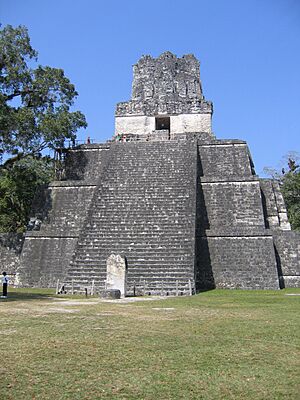Roof comb facts for kids

A roof comb is a special structure built on top of ancient Maya pyramids and other important buildings. Think of it like a fancy crown for a building! These tall, decorative parts were often covered in plaster and decorated with pictures of gods or powerful rulers. Each picture and symbol on a roof comb had a special, sacred meaning to the Maya people.
Roof combs usually sat on top of pyramids and other large structures. They were made from two walls that leaned against each other, creating a framework. This framework was then covered with plaster and decorated with art showing gods or important leaders.
History of Maya Roof Combs
The Maya people built some of the most amazing monuments in Mesoamerica. Their civilization had a "golden age" from about 500 to 900 AD. During this time, they created incredible cities and buildings.
Historians are learning more about Maya buildings by studying their hieroglyphs. These are picture symbols that tell us when buildings were made and who built them. The Maya loved to build tall structures, like pyramids with huge staircases, to reach towards the sky and their gods. Sometimes, new pyramids were even built right over older ones! This showed respect for ancestors and made the new buildings even taller.
Why Roof Combs Were Important
Large pyramids, platforms, and temples were used daily for religious events. The design of Maya cities showed who was important. Kings and rulers used grand buildings to show their power and to be remembered forever. Roof combs added unique designs to Maya architecture.
Symbolically, a roof comb was like a fancy headdress for the building. It looked like the tall, decorated headdresses worn by Maya kings and rulers. Architects wanted to make their buildings beautiful and special. They used roof combs to honor the great gods and leaders for whom the buildings were made.
How Roof Combs Were Built
Height was very important when the Maya built their monuments. Because of how they built arches (called corbel vaulting), many Maya buildings could only have a few stories. Architects worked hard to make their designs grand and memorable.
Most of the time, a roof comb did not help hold up the building. Instead, it was a beautiful, decorative part. Architects used a strong framework of stonework to create these combs. This method made them very strong and long-lasting. Roof combs were often carved or painted with images of animals, people, or special texts.
You can see some of the best examples of Maya roof combs at the great temples of Tikal. These temples were built as monuments for important rulers who had passed away. Their roof combs are covered with detailed and beautiful portraits and designs that honor them.

